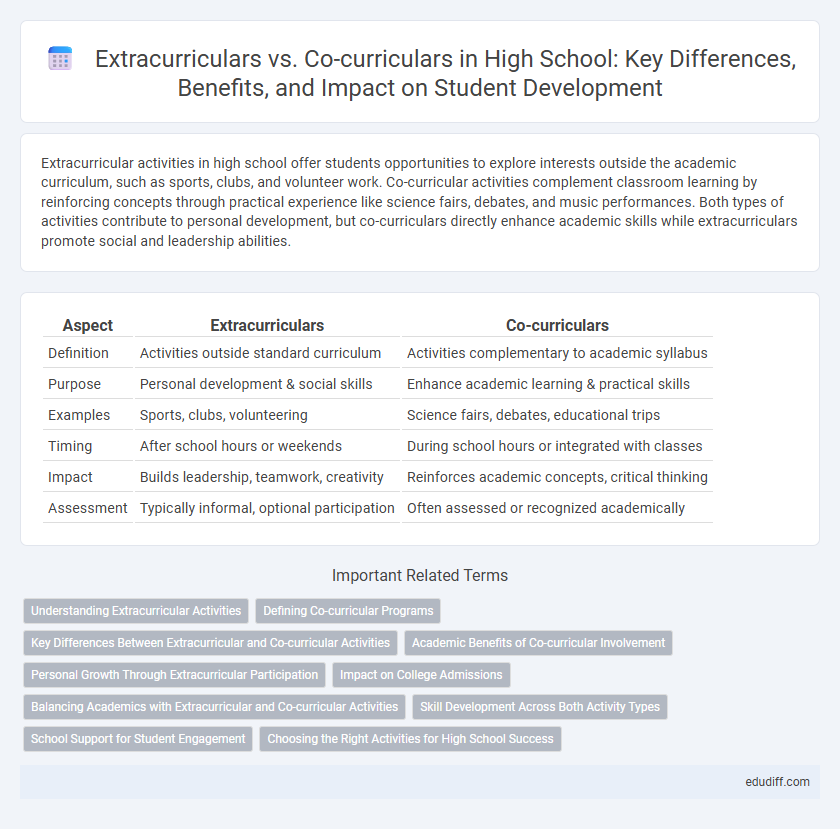Extracurricular activities in high school offer students opportunities to explore interests outside the academic curriculum, such as sports, clubs, and volunteer work. Co-curricular activities complement classroom learning by reinforcing concepts through practical experience like science fairs, debates, and music performances. Both types of activities contribute to personal development, but co-curriculars directly enhance academic skills while extracurriculars promote social and leadership abilities.
Table of Comparison
| Aspect | Extracurriculars | Co-curriculars |
|---|---|---|
| Definition | Activities outside standard curriculum | Activities complementary to academic syllabus |
| Purpose | Personal development & social skills | Enhance academic learning & practical skills |
| Examples | Sports, clubs, volunteering | Science fairs, debates, educational trips |
| Timing | After school hours or weekends | During school hours or integrated with classes |
| Impact | Builds leadership, teamwork, creativity | Reinforces academic concepts, critical thinking |
| Assessment | Typically informal, optional participation | Often assessed or recognized academically |
Understanding Extracurricular Activities
Extracurricular activities in high school include clubs, sports, and volunteer work that occur outside the standard curriculum, fostering personal interests and leadership skills. These activities enhance students' social development and college applications by demonstrating commitment and diverse talents beyond academics. Understanding extracurriculars is crucial for balancing schoolwork while gaining practical experience and building a well-rounded profile.
Defining Co-curricular Programs
Co-curricular programs in high school complement academic learning by integrating activities that enhance students' skills and knowledge alongside the curriculum, such as debate clubs, science fairs, and language societies. These programs promote holistic development by reinforcing classroom concepts through practical application, fostering critical thinking, teamwork, and leadership. Unlike extracurriculars, co-curriculars are directly linked to the academic syllabus, enriching students' educational experience and preparing them for academic and career success.
Key Differences Between Extracurricular and Co-curricular Activities
Extracurricular activities, such as sports, clubs, and arts, occur outside the formal academic curriculum and primarily focus on personal development and social skills. Co-curricular activities are integrated with the academic curriculum, like science fairs, debates, and field trips, enhancing learning by complementing classroom instruction. The key difference lies in their purpose: extracurricular activities foster interests beyond academics, while co-curricular activities reinforce and apply academic knowledge.
Academic Benefits of Co-curricular Involvement
Co-curricular activities such as debate clubs, science fairs, and math olympiads enhance critical thinking and subject comprehension, directly reinforcing classroom learning. These activities foster collaborative skills and intellectual curiosity, leading to improved academic performance and higher retention rates. Participation in co-curricular programs correlates with better time management and increased motivation, contributing to overall student success in high school.
Personal Growth Through Extracurricular Participation
Participation in extracurricular activities such as sports, clubs, and arts fosters critical life skills including teamwork, leadership, and time management, contributing significantly to personal growth. These activities provide students with opportunities to explore interests beyond the academic curriculum, enhancing social interactions and self-confidence. Engaging actively in extracurricular programs has been shown to improve emotional resilience and overall well-being during high school years.
Impact on College Admissions
Extracurricular activities such as sports, clubs, and volunteer work highlight a student's leadership, teamwork, and time management skills, often impressing college admissions officers looking for well-rounded candidates. Co-curricular activities, including academic competitions and school-based projects, demonstrate a student's commitment to intellectual growth and alignment with their academic interests, signaling strong dedication to their chosen field. A balanced portfolio of both extracurricular and co-curricular engagements strengthens college applications by showcasing diverse talents and a proactive attitude toward personal and academic development.
Balancing Academics with Extracurricular and Co-curricular Activities
Balancing academics with extracurricular and co-curricular activities enhances time management skills and promotes holistic development in high school students. Extracurriculars, such as sports and clubs, cultivate teamwork and leadership, while co-curriculars integrated with the curriculum reinforce academic concepts through practical application. Prioritizing responsibilities and setting realistic goals ensure students maintain academic performance and gain valuable life skills from both activity types.
Skill Development Across Both Activity Types
Extracurricular activities such as sports, clubs, and volunteer work develop leadership, teamwork, and time management skills outside the academic curriculum. Co-curricular activities integrated with coursework, like science fairs or debates, reinforce critical thinking, subject-specific knowledge, and communication skills. Both activity types complement each other, fostering well-rounded personal growth and enhancing college and career readiness.
School Support for Student Engagement
Extracurricular and co-curricular activities both play crucial roles in enhancing student engagement by offering diverse opportunities that complement academic learning. Schools invest in support systems such as dedicated coordinators, funding, and resource centers to facilitate student participation and skill development outside the classroom. Effective school support fosters a balanced environment where students can excel academically while nurturing social, leadership, and creative skills through various programs.
Choosing the Right Activities for High School Success
Choosing the right activities for high school success involves balancing extracurriculars like sports, clubs, and volunteer work with co-curriculars integrated into the academic curriculum, such as science fairs and debate teams. Prioritizing activities that align with personal interests and career goals enhances skill development, improves college applications, and fosters time management. Effective participation in both types contributes to a well-rounded education and promotes social, emotional, and intellectual growth.
Extracurriculars vs Co-curriculars Infographic

 edudiff.com
edudiff.com